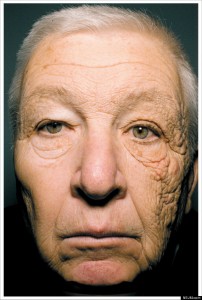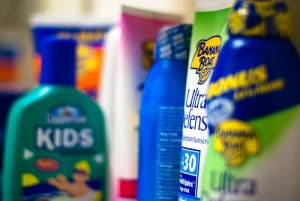That Texas sun is shining, and in addition to the heat, with it comes those skin damaging UV rays. According to the Skin Cancer Foundation, over 90 percent of the visible changes usually attributed to skin aging are caused by the sun, and over the last 30 years, more people have had skin cancer than all other cancers combined. It’s essential that we know how to protect our skin from the sun, so here are the top seven sunscreen myths debunked:
Myth #1: You don’t need sunscreen when it’s cloudy.
Nope. Clouds only block at most about 60 percent of the sun’s UV rays. Under some conditions,

Bill McElligott, a delivery truck driver, has significant UV damage on the side of his face that was always nearest the window of his truck. Source: HuffPost Living Canada
clouds may even increase the intensity of UV radiation. Spending most of the day outside on an overcast day can still lead to serious sunburns. And don’t think sitting inside the car or office all day will help, either. UV rays can easily pass through windows, too.
Myth #2: People of color don’t need to worry about sunscreen.
Incorrect. Melanin, the pigment that gives skin and eyes their color, does provide some protection. In African American skin, melanin provides a sun protection factor (SPF) approximately equivalent to 13.4, compared to 3.4 in white skin. While it is rare for black people to get melanoma, those who do have it are more likely to be diagnosed later and suffer more complications and even death. Something to remember: while melanoma normally shows itself on areas of the body regularly exposed to the sun, in those with darker skin tones melanoma tends to show up in less-typical places, including the fingernail beds, palms, and souls of the feet. Regularly examine your skin and see a doctor if something looks or feels different.
Myth #3: Sunscreen doesn’t expire.
I can tell you from personal experience that this is false. Sunscreen does, in fact, expire. Sunscreen that is a couple of weeks old or less will hold more true to its SPF rating. Remember to never leave sunscreen in a hot car or expose it to any other extreme heat, as this will cause the compounds to break down faster. Keeping it stored at room temperature will help it last as long as possible.
Myth #4: Higher SPF sunscreens work better.
Inaccurate. While an SPF above 30 may intuitively translate to more protection, this is not necessarily the case. But SPF 100 won’t provide twice as much protection from the sun than SPF 50. In reality, the difference is only one percent: SPF 50 blocks 98 percent of the sun’s rays, whereas SPF 100 blocks 99 percent. Buying sunscreens in the SPF 30-50 range should be fine, even for sensitive skin, and will save you money over higher SPF products.
Myth #5: Applying sunscreen only where the sun directly hits in enough.
Fallacious. Melanoma can occur anywhere on the body, including between toes, palms of the hands, even on your bum. Remember, when applying sunscreen, focus on behind the ears, back of the neck, back of the knees, and scalp. Check your body regularly for unusual spots or moles, and visit your doctor if anything seems unusual.
Myth #6: Chemicals in sunscreen are more dangerous than the sun’s damage.
No. There are two chemicals to watch for when buying sunscreen: avobenzone and oxybenzone. Avobenzone is not stable and tends to break down quickly and lose effectiveness. Oxybenzone has been found to disrupt hormone balance, and can be absorbed through the skin. These products should be avoided, but dermatologists warn that not using sunscreen is far more dangerous than exposure to any of the ingredients that might be used to make it.
Myth #7: 80 percent of sun damage occurs before the age of 18.
Nuh-uh. Actually, only about 23 percent of lifetime exposure occurs by age 18. It’s never too late to start protecting yourself!



